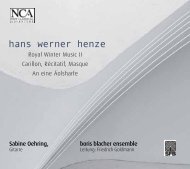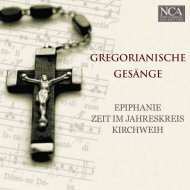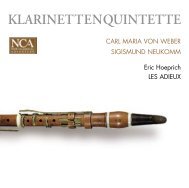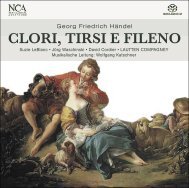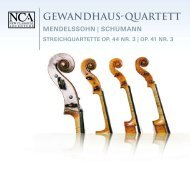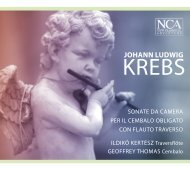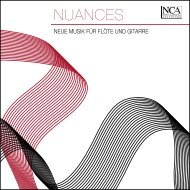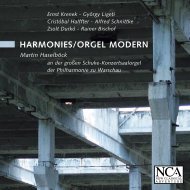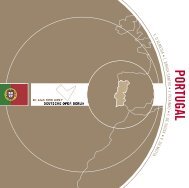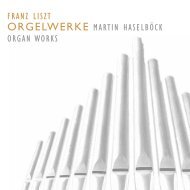FRANZ LISZT - nca - new classical adventure
FRANZ LISZT - nca - new classical adventure
FRANZ LISZT - nca - new classical adventure
- No tags were found...
You also want an ePaper? Increase the reach of your titles
YUMPU automatically turns print PDFs into web optimized ePapers that Google loves.
TASSO. LAMENTO E TRIONFO(“TASSO. LAMENT AND TRIUMPH”)Symphonic poem No. 2 after Lord ByronThe Symphonic poem No. 2 Tasso has, in commonwith most of the better-known works by Liszt, along and complex history. Its origins go back toan orchestral piece that he had composed as anoverture to Goethe’s play Torquato Tasso. It wasa component of the incidental music first heardduring the gala performance of the drama at theHoftheater, Weimar, the occasion being the poet’scentenary on 28 th August 1849. It was Liszt’s firstsignificant undertaking in a leading position during the technical “highlight” of the whole conception: gondoliers used to sing the first verse of Tasso’s poem describes under its title Lamento e trionfo24 25his service at Weimar as court music director.This overture had at first little to do with theplot of Goethe’s play, rather it went beyond thisto focus on the main character. Liszt’s individualconception was closer to Lord Bryon’s poem “TheLament of Tasso”, written in 1816 than on Goethe.Liszt intended – as can be assumed from the latersymphonic poem’s subtitle – using the example ofthe title role of Goethe’s drama to portray the lifeand fate of a great artist through music: “throughsuffering to triumph”. In Liszt’s concept the greatRenaissance poet Torquato Tasso was elevated instatus to the epitome of the artist.Consequently in the original version the work wasstructured in two large-scale sections. The first,Lamento (being indicative of Byron’s poem) andTrionfo (a victory symphony akin to Beethoven’s“Egmont” overture). The musical unity of the piece– and in this case the identity of the personalitydepicted in the music – is achieved through a noveltechnique of variation. This is simultaneously alsothe same two themes that at first describe Tasso’s“Lament” are reworked to provide music for the“Triumph” in the second part. Even the choice ofkeys is part of the programme. The work begins inC minor and changes in the second part to C major.Liszt’s Tasso is representative therefore of thosegreat works of the nineteenth century, which inthis sense paraphrase the model character ofBeethoven’s legendary fifth symphony: “Throughnight into light, through fight to might”.For the central part of the Lamento Liszt returnedto a piano work that makes its reappearance inthe overture more or less unaltered in orchestralcolours. It was the first of a series of piano piecesthat he had wanted to publish as early as 1840under the title Venezia e Napoli (the others wereadapted later for the supplement of the same nameto the “Italy” volume of the Années de Pèlerinage).The connection between the “Venice” piano piecesand the Tasso-Lamento was established in twoways. The historical Tasso had languished in aVenetian dungeon, and in the piano piece Liszt hadarranged a melancholy tune to which the Venetianepic poem “Jerusalem Delivered”. This melodyforms, as it were, the “spiritual” first subject ofthe work, though alongside the “real” first subject,the Tasso motto, with which the introduction tothe piece begins. This, although a development ofthe gondolier melody, appears as an independententity. In this way the piece has two main strandsthat are interrelated and which through theirtransformations characterise the progress of thework as a whole.When in 1854 Liszt eventually came toarrange the Tasso overture as an independentsymphonic work, calling it No.2 in the series ofhis symphonic poems, it appeared to him thatthe mere two-section form was not sufficientlygrand. He supplemented it through a third partin the distant key of G sharp minor, which heinterpolated between the two existing sections.Therein we hear variations of both Tasso themesthat together dance a delicate minuet – Tassoin the courtly atmosphere at Ferrara – wherebythe setting of Goethe’s play is also, if belatedly,represented musically. The completed symphonicin fact three stages in the poet’s life (as Lisztwrites in the introduction): Venice (dungeonimprisonment), Ferrara, Rome (coronation as“Poet laureate”).english



